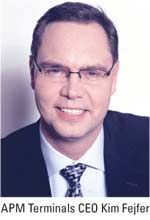
APM Terminals marked the occasion of its second “Global Safety Day” on October 22nd by introducing a comprehensive worldwide safety culture program for all terminal personnel. The goal of the new program will be to instill a “culture of safety” and the adoption of best-practice procedures into the daily operations of one of the world’s busiest container terminal networks. Noting that many of the safety procedure best practices can also be effectively implemented at terminals operated by other companies, APM Terminals CEO Kim Fejfer, based in The Hague, Netherlands stated, “As an industry, we should have zero tolerance for injuries and accidents. We feel terminal operating companies are not competitors but should consider themselves as partners in this initiative. The program aims to change mindsets and increase individual accountability through workshops prepared in twelve languages. We welcome the opportunity to share the enhancements and reforms this initiative will create."
With operations in over 50 terminals in 31 countries and five continents, APM Terminals is undertaking another important step toward eliminating fatalities throughout its Global Terminal Network. This will be accomplished through accident prevention awareness, an overview and reinforcement of operational safety procedures and the active encouragement of company and terminal personnel to adopt and embrace a new philosophy of workplace behavior in which safety is integrated into the core business processes.
Total container terminal handling volumes worldwide are approaching 500 million TEUs annually, including transshipments and empty repositioning, as international trade continues to expand. Industry analysts have projected container terminal traffic is to double to over 1 billion TEUs by 2020. The growth of the container industry clearly generates economic development but also the increased statistical risk of terminal accidents, and workplace fatalities. The inherent challenges of working with large vessels and multiple cranes will be increased as the vessels and cranes themselves become larger; the largest vessels currently in service have capacities of over 12,000 TEUs, and need to be serviced by gantry cranes over 20 stories high. Coordinating the simultaneous movements of ships, containers, cranes, trucks, barges and railcars during time-limited vessel calls has become an intricate science requiring ever-higher safety standards.










